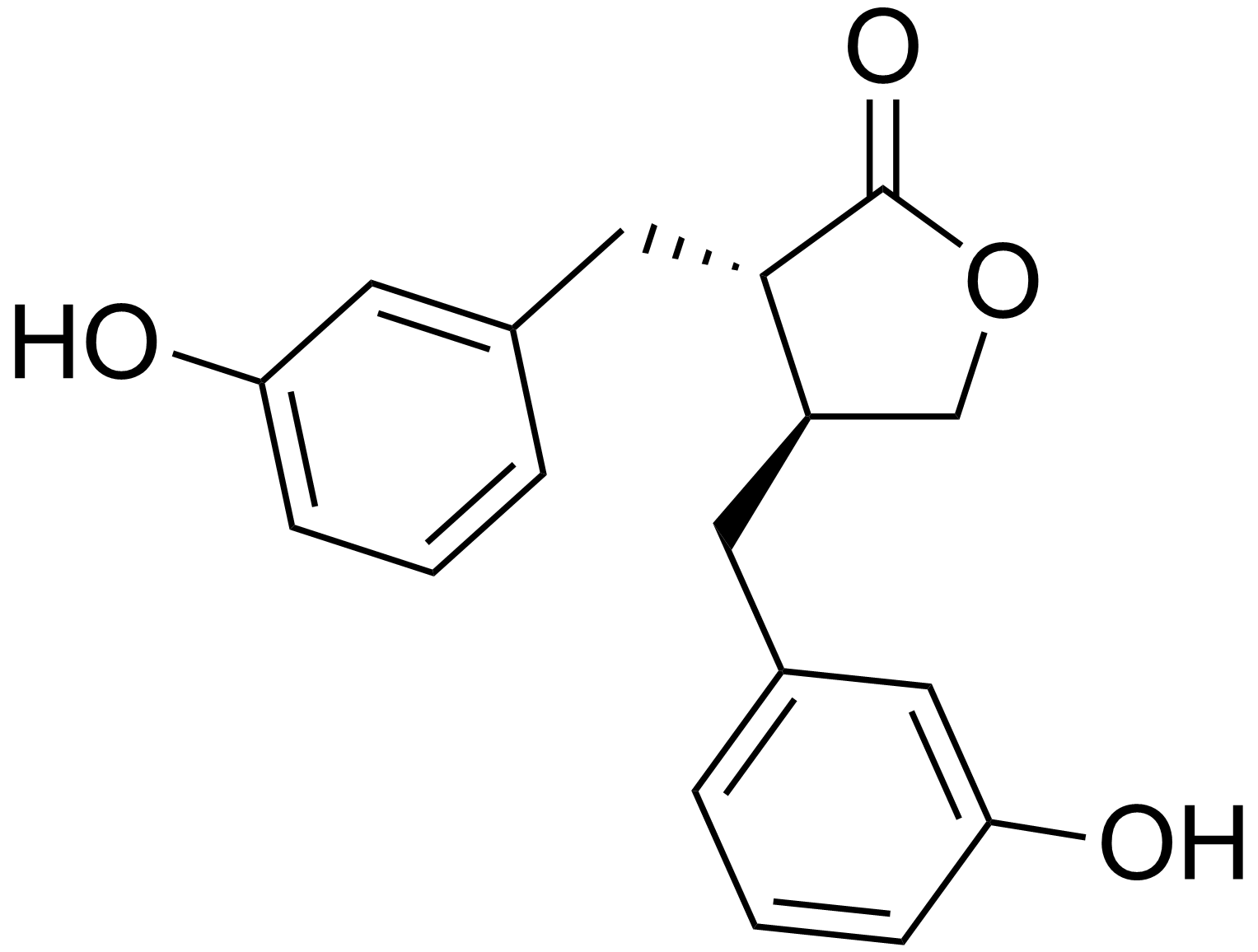- Spring Sale |
- About Us |
- VIP Shopper |
- Opportunity |
- Login
- | More
- | Lookbook
- | Choose your country
- |
- | Contact Us
Source: Nutr Rev. 2010 Oct; 68(10): 571–603. doi: 10.1111/j.1753-4887.2010.00319.x

The lignan content of foods is generally low and usually does not exceed 2 mg/100
g.
Lignan intake does not usually exceed 1 mg per day in most Western populations.
The
predominant plant lignan compound in foods, secoisolariciresinol diglucoside, is metabolized in the gut to
secoisolariciresinol, then to the enterolignan enterodiol and finally to enterolactone, but the conversion
is never 100%. The plant lignan matairesinol is metabolized directly in the gut to the enterolignan
enterolactone
Levels of enterolactone above 30 nmol/l or higher are protective, and levels below
15 nmol/l are too low to confer protections. Upper levels of enterolactone from diet appear to be 90-100
nmol/l, however variations in levels are high.147,
148 “
People simply do not have enough lignans in their diet to convert to enterolactone which confers protection. Until the introduction of Fountain of Life, flaxseed had been the gold standard for dietary lignans. However, for it to be converted to enterolactone, its lignan secoisolariciresinol diglucoside must be cleaved so only secoisolariciresinol is converted to an enterolignan. Fountain of Life is a much more efficient source to be converted to enterolactone. Flaxseed cannot be absorbed by the body unless the aglycone portion is removed through conversion in the human body. If this does not occur, flaxseed is not absorbed but eliminated by the body. Fountain of Life does not need this step and as a result, it is readily absorbed.
Source: https://pubmed.ncbi.nlm.nih.gov/20005303/
In conclusion, the present results indicate that HMR e effectively inhibits some functions of both monocytes as well as PMNs. The effect is exerted on key functional responses such as TNF-α and IL-8 secretion and on ROS production, which are of pivotal importance in the development of tissue and organ damages associated with inflammation, mainly in chronic disease. Such pharmacological and functional profiles which also include prominent antioxidant properties [7, 9] and mild proestrogenic activity [7, 14, 15], potentially support the health benefits of HMR in several conditions characterized by chronic systemic inflammation. In particular, the occurrence of such condition in asymptomatic people at high risk for cardiovascular events suggests the opportunity to assess in the subjects the usefulness of HMR supplementation as a safe and feasible dietary strategy

This study indicates and concludes that 7-HMR is a feasible and effective dietary supplement to lower ROS that can lead to issues such as cardiovascular disease.
Source: https://lpi.oregonstate.edu/mic/dietary-factors/phytochemicals/lignans
The enterolignans, enterodiol and enterolactone (Figure 1), are formed by the action of intestinal bacteria on lignan precursors found in plants (1). Because enterodiol and enterolactone can mimic some of the effects of estrogens, their plant-derived precursors are classified as phytoestrogens. Lignan precursors that have been identified in the human diet include pinoresinol, lariciresinol, secoisolariciresinol, matairesinol, and others .

The conversion to an enterolignan (enterolactone and enterodiol) is the main factor in bioavailability in the human body. 7-HMR (the predominant lignan in Fountain of Life) is very efficient, as it converts directly to the more powerful enterolactone without the need to cleave. Unlike flaxseed, which must go through this step, 7-HMR is converted quickly by the intestinal bacteria and absorbed in the body to address ROS that leads to chronic inflammation.
Source: J Am Coll Nutr. 2013 Dec; 32(6): 428–435.Published online 2013 Dec 10. doi: 10.1080/07315724.2013.849578

The results demonstrate that HMRlignan is quickly absorbed into the plasma and is metabolized to ENL in healthy postmenopausal women. Clinically, the data demonstrate a statistically significant improvement in hot flash frequency. Doses up to 72 mg/d HMRlignan for 8 weeks were safe and well tolerated in this population.
This demonstrates how dietary lignans can impact the health of menopausal and post-menopausal women, lowering hot flashes frequency.
Source: Sage Journal Volume 230, Issue 3
Our results suggest that dietary HMR started at the early phase of the tumour development inhibits the growth of the LNCaP human prostate cancer xenografts in athymic male mice.

Dietary lignans offer a significant impact on men’s health.
Source: Eur J Pharmacol. 2019 Jun 5;852:107-124. doi: 10.1016/j.ejphar.2019.02.022. Epub 2019 Feb 14.
"The in-vitro human cell culture studies provide strong evidence of the anticancer and
antimetastatic mechanisms of EL in several cancers. This comprehensive review supports an idea of projecting
EL as a promising candidate for developing anticancer drugs or adjunct dietary supplements and
nutraceuticals.”
This means that research is verifying the importance of enterolactone and that
adjunct supplements for our diets are being reviewed along with the incorporation of enterolactone in
anti-cancer therapy. Fountain of Life is your most powerful lignan source to help our bodies achieve the
enterolactone levels required for a higher quality of life.

This study shows the power of enterolactone, and how its potential may exert anticancer and antimetastatic benefits for those who have added lignans to their diet. Fountain of Life is your best source to create enterolactone as this lignan is in aglycone form that is readily absorbed in the body and converted efficiently to enterolactone.
Source: British Journal of Nutrition , Volume 120 , Issue 7 , 14 October 2018 , pp. 751 - 762
“Lignans are expected to have beneficial effects in humans after fermentative conversion in the colon to bioactive metabolites that may favourably influence parameters related to the metabolic syndrome( Reference Xu, Liu and Zhang27 ). Here we studied the effects of 7-HMR and TEP (a mixture of 7-HMR and allo-HMR) from P. abies as anti-obesity compounds at doses that can be reached through nutraceutical supplementation or approached with a lignan-rich diet( Reference O’Neill, Bohl and Gregersen28 )“We also found that total fat and isolated epididymal and gluteal fat pads were significantly smaller in the 7-HMR- and TEP-treated mice”“7-HMR and TEP lowered the lipid content in the liver”

In 2018, one of the definitive studies on the lignan 7-hydroxymatairesinol was published in the British Journal of Nutrition, detailing the impact of this lignan on health. Lowering LDL’s visceral fat, and fatty deposits on the liver while lowering insulin resistance were key takeaways from this study.
Source: The Key Laboratory of Modern Toxicology, Ministry of Education, School of Public Health, Nanjing Medical University, Nanjing 211166, China
Abstract:
Autism spectrum disorder (ASD) is a
heterogeneous, behaviorally defined neurodevelopmental disorder. Over the past two decades, the prevalence of
autism spectrum disorders has progressively increased, however, no clear diagnostic markers and specifically
targeted medications for autism have emerged. As a result, neurobehavioral abnormalities, neurobiological
alterations in ASD, and the development of novel ASD pharmacological therapy necessitate multidisciplinary
collaboration. In this review, we discuss the development of multiple animal models of ASD to contribute to
the disease mechanisms of ASD, as well as new studies from multiple disciplines to assess the behavioral
pathology of ASD. In addition, we summarize and highlight the mechanistic advances regarding gene
transcription, RNA and non-coding RNA translation, abnormal synaptic signaling pathways, epigenetic
post-translational modifications, brain-gut axis, immune inflammation and neural loop abnormalities in autism
to provide a theoretical basis for the next step of precision therapy. Furthermore, we review existing autism
therapy tactics and limits and present challenges and opportunities for translating multidisciplinary
knowledge of ASD into clinical practice.
Dietary supplement therapy.
Research studies have
reported that certain vitamins (e.g., vitamin B6, B12 and D; folic acid) [270,271], omega-3 polyunsaturated
fatty acids (PUFAs) [272], probiotics [273], and certain chemicals from plants (e.g., lignans and radicicicol)
have an effect on reducing hyperhomocysteinemia and gastrointestinal problems, as well as improve ASD
symptoms. Several studies have also reported positive results linked with general dietary treatments, such as
gluten-free and casein-free diets, which are thought to improve GI function, reduce gut flora dysbiosis, and
improve some ASD behavioral symptoms [274]. However, the efficacy and safety of such dietary therapies need to
be confirmed by further investigations.
In conclusion, nonpharmacological therapies can partially
alleviate symptoms of autism. Despite the absence of sufficient data, the therapeutic effects of behavioral
and psychological treatments, brain stimulation, and dietary therapies for individuals with autism appear to
have a theoretical basis in neurobiochemistry and signal transduction.

Lignans positively impact this condition and provide some symptomatic improvement. While this needs further investigation, this helps provide those affected with autism with a positive dietary change that could potentially alleviate some of the symptoms that they experience.
Source: Front. Pharmacol., 12 October 2022 Sec. Neuropharmacology Volume 13 - 2022
Background:
Alzheimer’s disease (AD) is a serious neurodegenerative
disease associated with the memory and cognitive impairment. The occurrence of AD is due to the accumulation
of amyloid β-protein (Aβ) plaques and neurofibrillary tangles (NFTs) in the brain tissue as well as the
hyperphosphorylation of Tau protein in neurons, doing harm to the human health and even leading people to
death. The development of neuroprotective drugs with small side effects and good efficacy is focused by
scientists all over the world. Natural drugs extracted from herbs or plants have become the preferred
resources for new candidate drugs. Lignans were reported to effectively protect nerve cells and alleviate
memory impairment, suggesting that they might be a prosperous class of compounds in treating
AD.
Objective:
To explore the roles and mechanisms of lignans in the treatment of
neurological diseases, providing proofs for the development of lignans as novel anti-AD
drugs.
Methods:
Relevant literature was extracted and retrieved from the databases
including China National Knowledge Infrastructure (CNKI), Elsevier, Science Direct, PubMed, SpringerLink, and
Web of Science, taking lignan, anti-inflammatory, antioxidant, apoptosis, nerve regeneration, nerve protection
as keywords. The functions and mechanisms of lignans against AD were summarized.
Results:
Lignans were found to have the effects of regulating vascular disorders, anti-infection,
anti-inflammation, anti-oxidation, anti-apoptosis, antagonizing NMDA receptor, suppressing AChE activity,
improving gut microbiota, so as to strengthening nerve protection. Among them, dibenzocyclooctene lignans were
most widely reported and might be the most prosperous category in the develpment of anti-AD
drugs.
Conclusion:
Lignans displayed versatile roles and mechanisms in preventing
the progression of AD in vitro and in vivo models, supplying potential candidates for the treatment of
neurodegenerative diseases.
Lignans positively impact this condition and provide some symptomatic improvement. While this needs further investigation, this helps provide those affected with autism with a positive dietary change that could potentially alleviate some of the symptoms that they experience.


According to the Finnish newsroom Metsateollisuus, “About 80% of domestic wood utilised
by the forest industry comes from private forest owners. The average size of the forest holding is 30
hectares and the number of forest owners is approximately 620 000.” They go on to state “Sustainable
forest management in Finland concentrates on finding a balance between economic, social and environmental
aspects. These are also the basic pillars for the two forest certification schemes PEFC and FSC that are
actively used in Finland.”
The Ministry of Agriculture and Forestry in
Finland
According to the Finnish government, The National Forest Strategy 2035 seeks
growing well-being from forests and for forests.
This will be achieved if:
- Finland is a competitive operating environment for a responsible forest-based
sector that is capable of renewing itself
- Forests are in active, sustainable and diverse use
-
We strengthen the vitality, diversity and adaptability of forests, andwe strengthen knowledge-based
management and competence in the forest-based sector.
- Sustainably managed forests enable diverse
ecosystem services regionally and nationally, and this also includes climate benefits. Wood is Finland’s
most important renewable resource.”